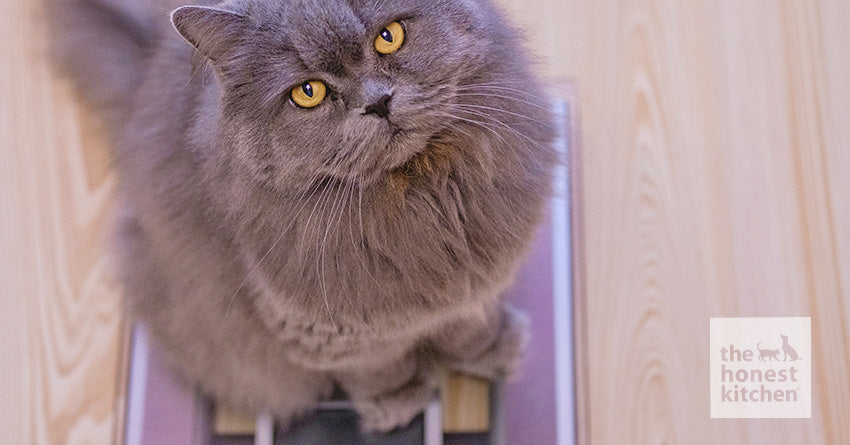As a pet owner, you’re probably very familiar with how picky your feline friend can be. At the same time, you most likely strive to feed them a balanced diet. Finding a sweet spot between healthy food and food your cat will enjoy can be tricky. In this article, we’ll cover what a healthy diet for a cat looks like, as well as several tips you can implement to maintain your cat’s health.
The Basics of Cats’ Nutritional Needs
Before we jump in, it’s important to remember that cats are obligate carnivores, meaning their bodies require certain nutrients that can only be found in animal sources.
But, just because cats are obligate carnivores doesn’t mean their diets should be 100% animal proteins. While cats typically don’t need special diets (unless directed by a vet), the general formula for a healthy cat diet is going to be high in protein, moderate in fat (and fat should be a mixture of saturated and unsaturated fats), and low in carbohydrates.
Let's explore a few other key nutritional needs for cats.
Water
Hydration is a key component in a cat’s diet. In fact, cats need to consume about four ounces of water per five pounds of lean body weight per day, according to Cornell University College of Veterinary Medicine. For example, this means that a 10-pound cat should drink about one cup of water per day. This hydration can be from plain water or wet, canned food, which may contain up to 80% water.
Water intake is vital for any living creature, but in cats specifically, dehydration can cause issues like kidney disease, diabetes, vomiting, diarrhea, hyperthyroidism, and more. So be sure you have multiple water options for your cat throughout your home.
Animal-Based Proteins
As mentioned, cats are obligate carnivores. Even domestic cats are very similar to their wild predecessors, so a house cat’s metabolism is well-suited for a strictly animal protein-based diet.
Fish proteins (tuna, salmon, sardines, mackerel) are ideal protein sources because they have healthy fats (omega-3 and omega-6), which are important for joint, coat, and bone health. Other sources of animal-based proteins include chicken, turkey, beef, and pork.
Amino Acids
Amino acids are vital to cats’ diets, specifically arginine and taurine.
Arginine is important to help cats convert ammonia into waste, so when there’s a deficiency, cats may experience diarrhea, vomiting, weight loss, and ataxia. Taurine, on the other hand, is essential for cats’ vision, digestion, and heart. Unlike arginine, a taurine deficiency can take many months to show and usually starts with a heart condition called dilated cardiomyopathy.
Other essential amino acids that are important to your cat’s health include:
- Histidine
- Isoleucine
- Leucine
- Lysine
- Methionine
Fatty Acids
Fatty acids are most well-known for keeping your cat's coat sleek and soft. These acids also help keep your cat’s skin healthy, reduce inflammation, and protect against certain types of cancer. The main essential fatty acids your cat needs include arachidonic acid (AA), eicosapentaenoic acid (EPA), and docosahexaenoic acid (DHA).
Focusing on fish oil can be great for your cat’s health as it's high in omega-3 fatty acids EPA and DHA. Omega-3 fatty acids can help with inflammation, skin diseases, asthma, and gastrointestinal disease.
Vitamins
You can think of the vitamins in your cat’s diet as the activators necessary for other enzymes to work. For example, vitamin D3 is necessary for cats to absorb calcium. Like humans, calcium is vital for strong bones, muscles, and the immune system.
Another vitamin essential to your cat’s health is niacin, a B vitamin. Without this vitamin, cats can experience a loss of appetite, inflamed gums, weight loss, and even hemorrhagic diarrhea.
Minerals
In addition to vitamins, several minerals are important to your cat's health, including iron, calcium, magnesium, potassium, chloride, and sodium.
When it comes to vitamins and minerals, most of the time, cats need limited quantities of them — and if they have too much of one, it can cause toxicity. There have been numerous studies in recent years around vitamin D3 toxicity in cats, including one from the Department of Veterinary Medical Sciences at the University of Bologna in Italy.
Healthy Diets for Different Life Stages
In addition to cats' overall nutritional needs, you’ll also want to consider your cat's life stage when determining their diet.
Kittens
Depending on how young your kitten is, it’s important to know what type of food to introduce to your cat and when. After milk-feeding, it's time to introduce your kitten to solid foods. Because of their small teeth, it may be a good idea to start with wet food and gradually transition to kibble or dry food.
The most significant areas to note when it comes to nutritional needs for kittens are caloric intake, as well as protein and fat content. Kittens typically require a high-fat, high-protein diet with DHA to support brain, vision, and cognitive development.
Adult Cats
Diets for an adult cat differ from a kitten in that they do not need as many calories and as much fat as they did in their peak growing months. At about one year old, feeding once or twice a day is appropriate for most cats. You may also consider the type of lifestyle your cat has. Do they live indoors, or do they roam outside? These factors can help determine what diet is right for your cat.
In addition to assessing your cat's lifestyle and activity level, it’s important to keep an eye on their weight, as around 50% of adult cats are considered obese, according to VCA Hospitals.
Senior Cats
Since activity levels drop in most cats’ senior years, they no longer need as much food. Many cat owners free-feed, which means they leave food out all day. So one great way to avoid the weight gain that comes with age is to ensure you feed your cat twice a day versus free-feeding (which is a key reason cats are overweight).
8 Tips for Maintaining a Healthy Diet for a Cat
Now that we’ve covered overall nutritional needs and notes based on your cat's age, let’s get into some specific tips you can implement right away to help keep your cat happy and healthy.
1) Visit a Veterinarian Regularly To Understand Your Cat’s Needs
Just like humans, our pets need to go to the doctor regularly to get a complete physical, get necessary booster shots and vaccines, and check for any signs of concern. Typically a once-per-year checkup is appropriate for cats with normal health. This is also a great opportunity to discuss your cat’s diet with your vet.
2) Use Human Grade Cat Food
We may be biased, but human grade cat food is a great option for any cat and can take their nutrition to new heights as it contains clean, nutrient-dense, minimally processed ingredients. Additionally, human grade pet food is made with human-edible ingredients and processed in a plant for human food, unlike commercial cat food.
If you’re looking for a great place to start with human grade cat food, look no further than The Honest Kitchen's line of healthy, delicious recipes for cats of all life stages.
3) Keep Your Cat Well-Hydrated With Wet Food
As mentioned earlier, hydration is key to your cat’s health. Higher-moisture diets can mean less chance of urinary tract infections and other diseases. So, choose cat food with more water, or you can try adding water to your cat’s current food. Just make sure you start this process gradually, as too much hydration too fast can lead to loose stool.
4) Look for Food Products That Meet AAFCO Guidelines
The Association of American Feed Control Officials (AAFCO) offers several recommendations about pet foods. Though the AAFCO doesn’t endorse any particular cat food brand, it does recommend specific nutrient balances. For adult cats, AAFCO standards recommend the following minimums:
- Protein: 26%
- Arginine: 1.04%
- Taurine: 0.10% to 0.20%
- Fat: 9%
5) Transition to New Foods Gradually
Based on what you’re reading in this article, you may consider switching your cat’s food — but don’t take the leap too quickly. It’s vital to your cat’s health to transition to new food gradually, as cats can have sensitive stomachs. It’s best to slowly mix new food into your cat’s current food and increase it little by little over a week or two.
In addition to helping your kitty’s tummy acclimate to the new food, it may also increase the chances of them truly enjoying the new food instead of one day taking away their old food and replacing it with something entirely new.
Check out these additional tips for transitioning your cat to a new food.
6) Avoid Free-Feeding
Though your cat may love to graze on kibble all day, free feeding is not the best option for adult and senior cats. It can encourage overeating, which can lead to weight gain. Additionally, free feeding can interrupt stable blood sugar levels in your cat, which can put excess stress on the pancreas.
7) Be Aware of Signs of Obesity and Malnutrition
If you are worried about your cat's health, we recommend looking out for various signs that may point to obesity or malnutrition. If you notice any of the following signs, schedule an appointment with your vet immediately.
Signs of Obesity
- They have a difficult time jumping or climbing stairs.
- They have lost their visible waistline.
- You can no longer feel their rib or hip bones.
- Their coat is dirty, messy, or unkempt (may be a sign they are unable to groom themself).
- They have less frequent bowel movements.
Signs of Malnutrition
- Weight loss
- Weakened muscles (unable to do things like jump up stairs or to a cat tree like they used to)
- Poor coordination
- Fatigue or lethargic behavior
- Lack of grooming
- Dry or scaly skin
- Swollen gums

8) Encourage Physical Activity
Lastly, one of the best ways to support a healthy diet in your cat is to encourage physical activity. This can help maintain a healthy weight and keep your pet happy through the socialization that physical activity often requires. Here are some ideas:
- When you feed your cat, make them do a little bit of exercise to get to their food, such as putting it on the opposite end of your house.
- For cats that aren't suffering from osteoarthritis, you can make them climb a flight of stairs to get to their food.
- You can hide their food, which triggers their instinctual hunting behavior. This is also a great mental stimulant.
Maintain a Healthy Diet for Your Cat With The Honest Kitchen
Ensuring your feline friend stays healthy can require a bit of strategy and research, but if you can get into a habit and establish a routine with your cat, you will both benefit.
Transitioning to food from The Honest Kitchen can simplify this process. We have a ton of great recipes for young cats and kittens to adult and senior cats, full of nutrient-dense ingredients your cat will find delicious. Explore The Honest Kitchen’s human grade cat food today.
*Health Disclaimer: This post is educational in nature and doesn’t constitute health advice. Please consult your pet's veterinarian or other healthcare professional for specific guidance on this topic.

